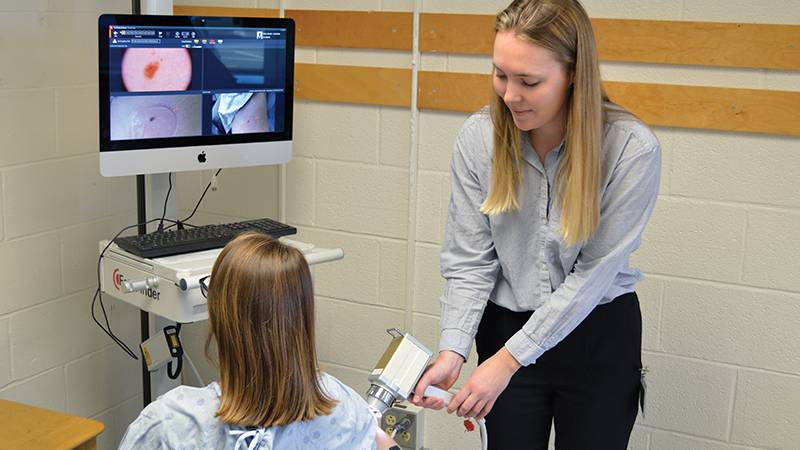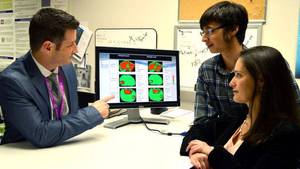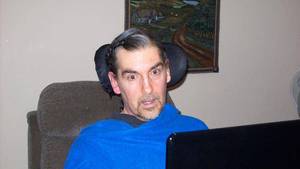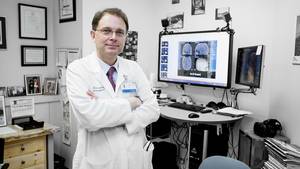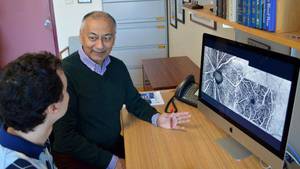Concerned a new mole on her body might be cancerous, Jessica Howe immediately contacted a research study taking place at the QEII Health Sciences Centre.
Jessica, an administrative assistant at the QEII, spotted a bright yellow poster advertising the Direct Access to Melanoma Identification and Treatment (DAMIT) study in the elevator at work one day last fall. It called on people like her to take part in the study that detects melanoma, a life-threatening form of skin cancer, with a non-invasive machine that uses artificial intelligence.
“I had a new mole that came out of nowhere and I also had some soreness around it,” says Jessica. “I was concerned.”
The DAMIT study, supported by the Dalhousie Medical Research Foundation’s Shaw Endowed Fellowship in Melanoma Research, is aimed at the early detection and treatment of melanoma. Dr. Peter Hull, the QEII’s head of dermatology and the physician leading the study, is calling on the public to contact his team about concerning moles. Finding melanoma early is crucial. The detection of thin, curable melanomas can save lives. In Nova Scotia, this is critical.
“We have the highest rates of melanoma across the country,” says Dr. Hull. “We have a real epidemic.” Each year in Nova Scotia, there are more than 18 cases of melanoma detected per 100,000 people.
Dr. Hull attributes the province’s high rates to genetics, jobs and lifestyles. A large proportion of residents, like fishermen, work outdoors in the sun and outdoor recreational activities are growing in popularity.
Not wanting to wait and worry, Jessica called to find out more about the study. Emma Price, the study’s research co-ordinator, told her all she needed was to be 25 years or older and have a mole that was worrying her. She didn’t need a referral from a doctor. Jessica wasn’t sure what she should be looking for. She learned that the research team is particularly concerned about smooth moles.
“Moles rough on the surface are very unlikely to be melanoma,” says Dr. Hull. “We talk about the ugly duckling — a mole that looks different and is changing over a month. It doesn’t matter if it is a colour change or a size change. Those are all important.”
After expressing interest in the study and signing a consent form, Jessica was told patients are seen within one or two weeks.
During a typical meeting with a patient, Emma spends about 30 minutes with them. After learning about the history of the mole and what is concerning the patient, Emma then takes a dermoscopic image using a special camera that magnifies the mole 20 times and shines non-polarized light. This allows the team to see structures of the mole that can’t be seen with the naked eye. The dermoscopic image makes it easier for the artificial intelligence to diagnose melanoma.
The image is then analyzed by a computer to determine if it is safe or needs to be removed. It detects melanoma with a high level of accuracy.
The research team also uses a special tape to sample the surface of the patient’s skin, analyzing the samples for genes only seen in melanoma.
Within 24 hours of taking the image of the mole, Dr. Hull examines it and determines whether the mole should be removed. Moles are never burned off, he explains. If removal is necessary, it will take place within two weeks.
Jessica learned her mole wasn’t cancerous, but it was removed just to be safe. “It was all completed within a three-week period,” she says. “It was very relieving to get in and get it dealt with so quickly.”
Taking part in the study allows patients to greatly reduce the amount of time they wait to see a specialist and have a mole removed, says Dr. Hull. Typically, it could take as much as six months to get an appointment with a dermatologist to check a mole.
Dr. Hull hopes his study will continue for at least two years and include 1,000 patients. Eventually, he would like to see the technology used to establish public centres in the province that would screen for cancerous moles, similar to breast-screening centres.
Approved by Nova Scotia Health Authority’s Research Ethics Board, the study is free for participating patients. For more information or to take part in the study, contact damit.program@gmail.com.

